Processed Through USPS Regional Facility: What It Means
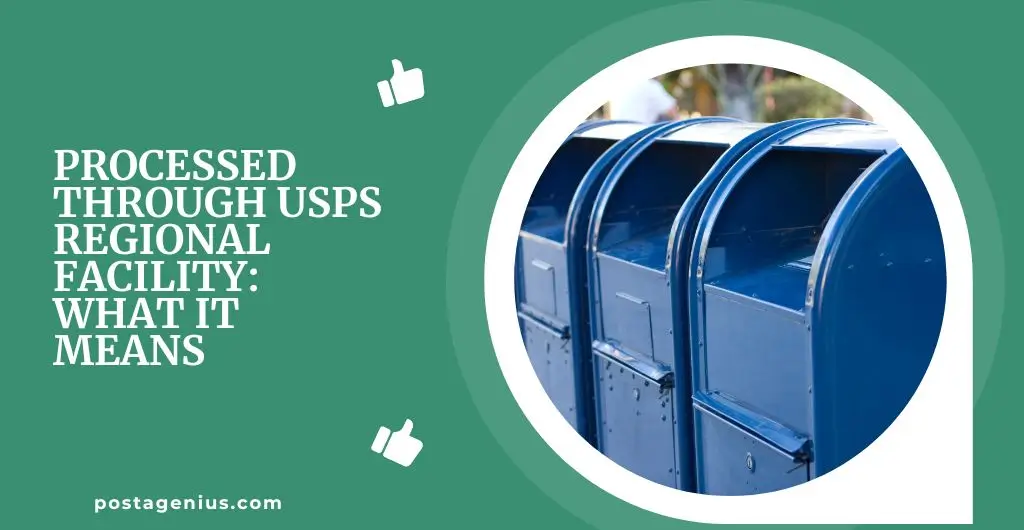
Navigating the journey of a package through the USPS system can sometimes be confusing. One common notification you might see is “processed through USPS regional facility.”
This means your mail or package has passed through one of the many large processing centers that serve as transit hubs.
These facilities are essential for sorting and moving the enormous volume of mail that USPS handles—over 116 billion pieces each year.
Understanding what happens at these regional hubs and knowing when to be concerned about delays can help provide peace of mind as you track your shipment.
Contents
- 1 An Understanding of Mail Processing Through USPS Regional Facility
- 1.1 What are USPS regional facilities?
- 1.2 Why your mail goes through regional facilities during transit
- 1.3 What happens during and after regional facility processing?
- 1.4 How long should mail be at a regional facility?
- 1.5 What if my package spends “too long” at a regional facility?
- 1.6 When should I worry about “processed through regional facility” scans?
- 1.7 USPS vs. FedEx vs. UPS: Comparative Analysis of Regional Facilities for 2024
- 1.8 Key takeaways on USPS regional facility processing
- 1.9 Conclusion
- 1.10 Frequently Asked Questions
- 1.10.1 How many regional facilities does USPS operate?
- 1.10.2 What volume of mail do they process?
- 1.10.3 What are some other names for regional facilities?
- 1.10.4 Where can I find the location of the regional facility handling my mail?
- 1.10.5 Why does mail have to move through so many facilities?
- 1.10.6 How fast does mail move between regional facilities?
An Understanding of Mail Processing Through USPS Regional Facility
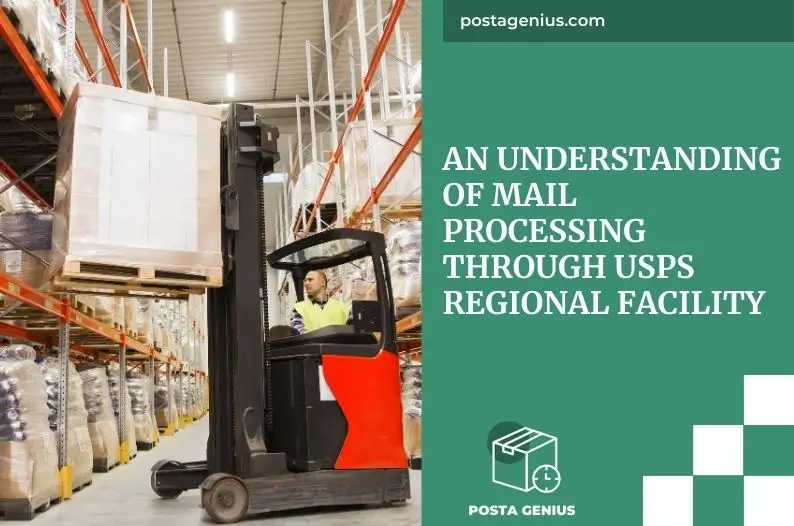
What are USPS regional facilities?
USPS operates a vast network of mail processing and distribution centers strategically located across the United States.
These facilities, commonly referred to as regional facilities, are crucial in the transportation and sorting system of USPS.
My firsthand experience with USPS has shown that these regional hubs are vital for efficient processing and timely delivery of mail pieces.
Each regional facility acts as a central hub connecting local post offices to a broader network of trucks, planes, and other transportation methods, ensuring the smooth flow of mail across different regions of the country.
The USPS San Francisco Distribution Center is a prime example, managing the bulk of mail for the West Coast, while the Southern Maryland Processing and Distribution Center serves the Mid-Atlantic region.
With 60 such plants, USPS efficiently handles more than 116 billion mail pieces annually.
These regional facilities are indispensable in maintaining the seamless movement of mail between various geographic regions, showcasing the immense scale and organization behind USPS’s operations.
Explore this article : UPS Tracking Older Than 120 Days
Why your mail goes through regional facilities during transit
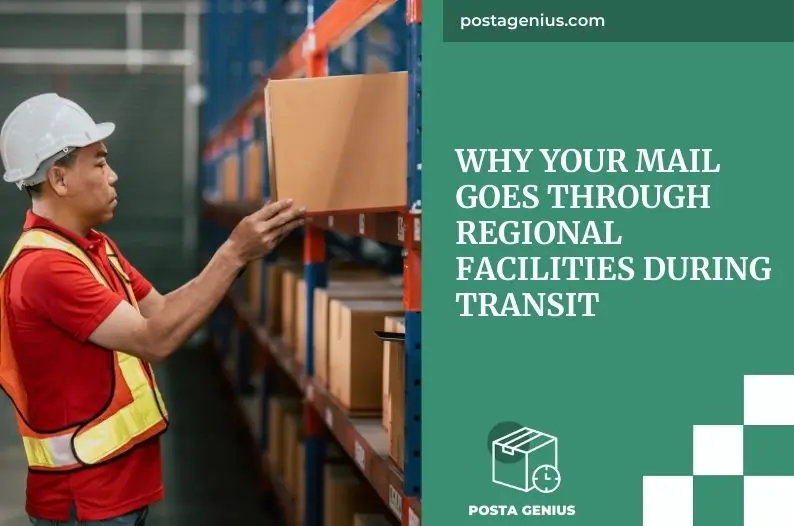
When your package or letter is marked as “processed through regional facility,” it signifies that it has passed through one of USPS’s large plants.
These regional facilities play a crucial role in ensuring that your mail is efficiently routed and delivered. Local post offices collect outgoing mail and send it to these facilities for consolidating before it heads to different regions.
This consolidation allows bundles of mail destined for the same place to be transported more efficiently.
At these regional plants, sophisticated sorting machines organize incoming mail by ZIP Codes, ensuring it reaches the correct local post office nearer its ultimate destination.
Additionally, these facilities are directly connected to airplanes, trucks, and other modes of transportation that move large volumes of mail between regions overnight.
The journey your package takes across the country involves passing through these transit hubs, enabling USPS to quickly move millions of pieces of mail between different cities and states.
What happens during and after regional facility processing?
Unloading and Initial Processing
Once your mail arrives at a regional distribution center, it goes through several crucial steps before continuing its journey to you.
The process begins with unloading as trucks deliver mail and packages from local post offices to the large regional facility. Here, consolidated bundles of mail are unloaded and moved to the next stage.
During processing, both machines and manual sorters handle letters and flats by ZIP Codes, while packages are sorted by their destination zones. Additionally, address scanning ensures the correct delivery points are verified.
Transportation and Final Delivery
Following this, the sorted mail gets loaded onto trucks, planes, and other vehicles for overnight transportation between regions.
Upon arrival, the mail destined for local delivery is transported to the nearest local post office. Here, it is loaded onto routes for the mail carriers who will deliver the processed mail to homes and businesses.
Typically, after passing through the regional facility, your mail will arrive at your local post office within a day or two, ready to be delivered.
These regional plants enable the fast processing of millions of mail pieces across a broad geographic area, ensuring timely and efficient delivery.
How long should mail be at a regional facility?

Factors Affecting Processing Time
There is no firm rule for how long mail will stay at a regional distribution center before moving again.
Some packages may only need a few hours of processing, while others could be there for up to a day or two, depending on transportation connections.
Various factors can impact this duration, such as the volume of mail. During holidays, there is often a huge spike in the number of mail pieces, which can lead to longer processing time.
Additionally, if transportation connections are limited, the mail might have to wait for specific trucks or flights.
Priority and Errors
Another crucial factor is the priority of the mail. First Class mail gets priority over slower classes at each processing step.
Errors like missed scans or unreadable addresses can also cause sorting delays. Bad weather can further delay transport between facilities.
The size of the facility also matters; larger facilities can handle more volume than smaller ones, which may impact how quickly mail is processed.
Typical Processing Duration
While there is no definitive answer, the goal of the regional plants is to process huge volumes of mail quickly, ideally within a day or two.
These facilities are built to manage large amounts of mail efficiently. However, you should only start to worry about lost mail if there are no scans or updates for several days, as this might indicate a more significant issue.
Read Also: Clearance in Progress
What if my package spends “too long” at a regional facility?
If you notice your package seems to be stuck at a regional facility for several days with no further scans or updates, there are a few steps you can take.
First, double-check the tracking number on the USPS website to ensure it is correct. Look for other indications besides just “processed through regional facility.”
Next, look up the exact location of the regional facility and call the consumer affairs number to inquire about your package.
You can also visit your local post office and talk to them about your package’s status in more detail.
If necessary, file a missing mail claim online at USPS.com or call USPS customer service at 1-800-ASK-USPS. Additionally, you can request the local postmaster to do a package trace within the facility.
However, keep in mind that brief facility delays of even 2-3 days are not uncommon.
It is recommended to give it several days before calling USPS to open an investigation if there are no scans for 4+ days or if the expected delivery date has passed. These steps can help ensure your package is tracked and delivered promptly.
When should I worry about “processed through regional facility” scans?
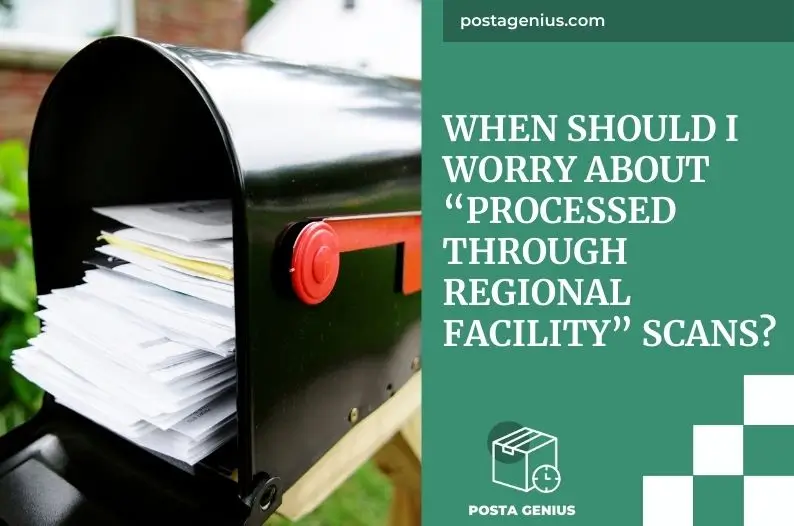
In most cases, seeing the “processed through regional facility” scan is a routine part of a package’s journey and not a cause for concern.
However, certain circumstances may warrant a call to USPS. For instance, if no location or city is listed and it just says “processed through regional facility” with no details for over 2 days, this might be a red flag.
Similarly, if there are no further scans after drop off, with the only scan being the regional facility and no delivery confirmation several days later, it’s time to investigate.
Another concern is when the package goes in the wrong direction, heading to a facility nowhere near its destination.
If the expected delivery date has passed with no package, or if it processed through multiple facilities over 4+ days, there could be an issue.
A package that is stuck in transit for several days after facility processing, with tracking showing “in transit to next facility,” also indicates a problem.
Unless you notice these red flags, a normal “processed through regional facility” scan simply means your mail is moving one step closer to its destination.
USPS recommends checking back in 24-48 hours for another scan update to confirm it is on the move.
By keeping an eye out for these specific signs, you can determine when it’s necessary to contact USPS for further assistance.
USPS vs. FedEx vs. UPS: Comparative Analysis of Regional Facilities for 2024
When comparing USPS’s regional facilities with those of competitors like FedEx and UPS, several key factors come into play, including efficiency, technology, and customer satisfaction.
Here’s a brief overview:
Efficiency
USPS:
- Network Size: USPS operates around 60 major regional processing plants along with numerous auxiliary facilities, handling over 116 billion pieces of mail annually.
- Processing Time: Mail typically spends 1-2 days at a regional facility being processed and sorted before moving closer to delivery.
- Recent Developments: The USPS is implementing a “Delivering for America” plan, aiming to modernize and expand its network to improve efficiency and service quality.
FedEx:
- Network Size: FedEx has approximately 39 regional hubs in the U.S. as part of its FedEx Express network, in addition to FedEx Ground facilities.
- Processing Time: FedEx’s Priority Overnight service ensures next-business-day delivery, while standard Ground service takes 1-5 business days.
- Efficiency: Known for its rapid overnight delivery services, FedEx is highly efficient, particularly for urgent shipments, often leveraging advanced automation in its hubs.
UPS:
- Network Size: UPS operates more than 1,800 facilities globally, including major sorting hubs and regional centers.
- Processing Time: UPS Next Day Air ensures overnight delivery, while UPS Ground typically takes 1-5 business days.
- Efficiency: UPS is renowned for its reliable and consistent delivery times, supported by an extensive logistics network.
Keep Reading: In Transit to Next Facility
Technology
USPS:
- Automation: USPS has been integrating automation and AI in sorting and processing, enhancing efficiency and accuracy.
- Tracking: The USPS mobile app and website provide real-time tracking updates, though some users report delays in scan updates.
- Innovations: Ongoing efforts to incorporate advanced technologies to streamline operations and improve delivery times.
FedEx:
- Automation: FedEx uses advanced automation in its hubs, particularly in major facilities like the Memphis Super Hub, to handle high volumes efficiently.
- Tracking: FedEx offers robust tracking capabilities with real-time updates and predictive delivery windows.
- Innovations: FedEx continually invests in technology, such as autonomous delivery vehicles and drones, to improve last-mile delivery.
UPS:
- Automation: UPS utilizes sophisticated automation systems in its Worldport hub in Louisville and other major facilities to enhance processing speed.
- Tracking: UPS provides detailed tracking information with live updates and estimated delivery times.
- Innovations: UPS is pioneering the use of electric vehicles, drones, and advanced route optimization algorithms to boost efficiency and sustainability.
Customer Satisfaction
USPS:
- Service Levels: Offers a range of services from economy to expedited, catering to various customer needs.
- Customer Support: Improved but still noted for occasional delays and issues with missing mail claims.
- Satisfaction: Generally positive feedback for affordability and nationwide coverage, though some customers experience inconsistencies in delivery times.
FedEx:
- Service Levels: Known for premium services, particularly in overnight and international shipping, with a focus on speed and reliability.
- Customer Support: Highly rated for responsive and effective customer service, though premium services can be costly.
- Satisfaction: High customer satisfaction for speed and reliability, especially for urgent shipments.
UPS:
- Service Levels: Offers a broad range of services, including same-day, next-day, and ground shipping, with a strong focus on reliability.
- Customer Support: Praised for effective customer support and comprehensive online tools for managing shipments.
- Satisfaction: Generally high satisfaction due to reliable delivery times, excellent tracking, and customer service.
| Feature | USPS | FedEx | UPS |
| Network Size | ~60 major regional processing plants | 39 regional hubs in the U.S. | 1,800+ facilities globally |
| Processing Time | 1-2 days per regional facility | Priority Overnight, Ground: 1-5 business days | Next Day Air, Ground: 1-5 business days |
| Efficiency | Moderate, improvements underway with Delivering for America plan | Highly efficient, known for rapid overnight services | Renowned for reliable and consistent delivery times |
| Automation | Integrating AI and advanced sorting technologies | Advanced automation in major hubs | Sophisticated automation systems in major facilities |
| Tracking | Real-time updates, sometimes delayed | Robust, real-time updates and predictive delivery windows | Detailed tracking with live updates and estimated times |
| Innovations | Ongoing tech integrations and sustainability efforts | Autonomous vehicles, drones | Electric vehicles, advanced route optimization |
| Service Levels | Range from economy to expedited | Premium services, focus on speed and reliability | Broad range of services, strong focus on reliability |
| Customer Support | Improved but with occasional delays/issues | Highly rated, responsive | Praised for effective support and comprehensive tools |
| Customer Satisfaction | Generally positive for affordability, some inconsistency | High satisfaction for speed/reliability | High satisfaction for reliability and service |
Key takeaways on USPS regional facility processing
- Regional facilities are large mail processing plants that act as transit hubs for mail transportation.
- Packages typically spend 1-2 days at a regional facility being processed and sorted before moving closer to delivery.
- There are legitimate reasons for some delays, but you can contact USPS if a package appears stuck.
- Repeated “processed through” scans at multiple facilities over several days could indicate a problem.
- “Processed through regional facility” means your mail is in transit as expected unless other red flags arise.
- USPS processes over 129 billion mail pieces annually, so delays at busy facilities are to be expected at times.
Check This Out: Shipment Ready for UPS
Conclusion
Understanding the role of USPS regional facilities in processing and moving your mail is key to managing expectations and avoiding unnecessary worry.
These centers are crucial for handling the vast amount of mail efficiently. By keeping an eye on tracking updates and knowing when to take action, you can ensure a smoother delivery experience for your packages.
Frequently Asked Questions
How many regional facilities does USPS operate?
USPS currently operates 60 major regional processing plants across the United States as part of its ongoing network expansion.
In addition to these primary facilities, there are also numerous smaller auxiliary facilities that support the efficient handling and sorting of mail.
These large plants are designed to process millions of mail pieces each day, significantly contributing to the USPS’s ability to handle the vast volume of mail it processes annually.
What volume of mail do they process?
In 2023, USPS handled 116.2 billion pieces of mail. Much of this volume passed through their extensive network of regional processing centers.
These large plants, capable of processing millions of pieces daily, play a crucial role in ensuring efficient sorting and transportation of mail across the country.
What are some other names for regional facilities?
These facilities may be referred to as distribution centers, regional distribution centers, processing and distribution centers, or simply processing facilities.
Regardless of the name, they all function as transit mail hubs.
Where can I find the location of the regional facility handling my mail?
Review the tracking details on USPS.com or the USPS mobile app to find the city of the facility.
If necessary, you can then search online for the contact information of that facility.
Why does mail have to move through so many facilities?
The “wheel and spoke” system enables the consolidation and sorting of mail destined for the same regions, leading to more efficient transportation.
This system also helps USPS adhere to delivery timetables and standards.
How fast does mail move between regional facilities?
Mail usually travels overnight by air or truck between different facilities. USPS has set up transportation schedules to ensure that mail moves swiftly and efficiently across the country.
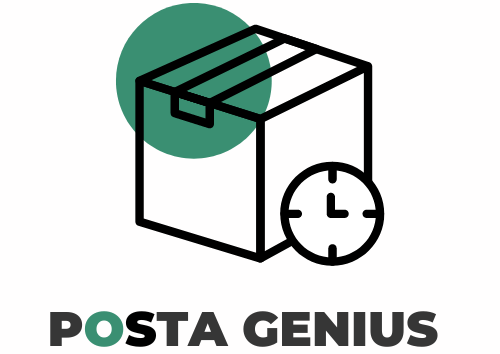

![Unveiling [USPS Mystery] Package Moved Left, No Address](https://postagenius.com/wp-content/uploads/2024/02/Unveiling-USPS-Mystery-Package-Moved-Left-No-Address.webp)


